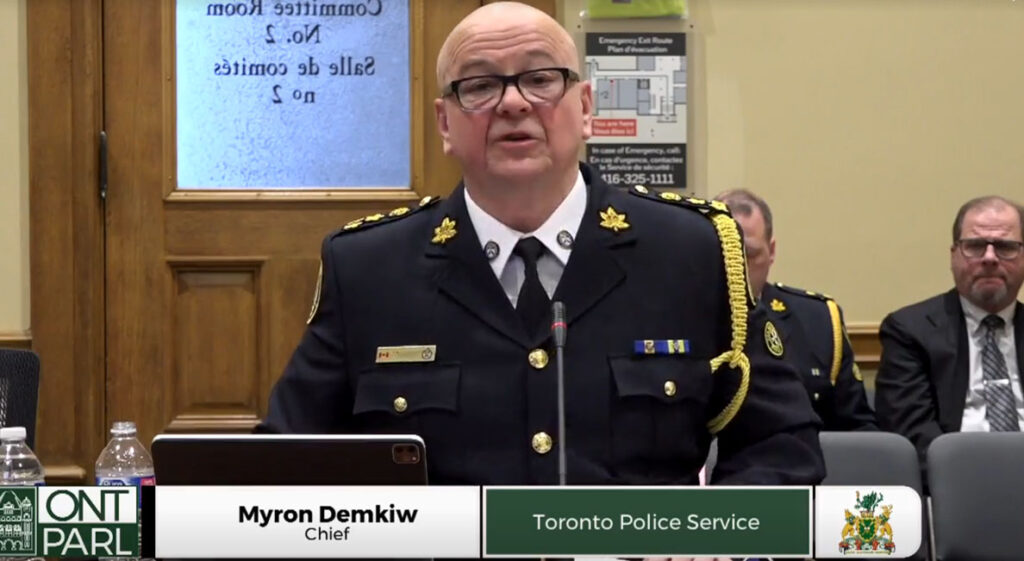Let’s be honest, something is not working with our current bail system in Canada.
On December 27, Constable Greg Pierzchala from the Ontario Provincial Police was shot and killed while on duty on a rural road outside of Hamilton. His presumed killer was out on bail awaiting trial for accusation of assault and several weapons charges.
Sadly, this isn’t the only recent example. In early July 2023, a man released on bail for crimes like break and enter, theft of a motor vehicle, flight from a peace officer, and dangerous driving (amongst other charges) viciously stabbed another passenger on a packed subway in downtown Toronto. Not only was the man out on bail, but he had also missed a court appearance earlier that morning.
It’s shocking and unnecessary incidents just like these that have Canadians asking themselves: why was this person allowed to be out of jail? The question is not if we need to fix this flawed system but how do we fix it. When criminals are released on bail and continue to commit crimes, police spend time and resources to bring them back into custody. Improving the current bail system brings a lot of positive effects on public safety and policing resources, allowing police to redirect their efforts towards crime prevention, community engagement, and other important proactive initiatives.
Let’s start with the basics:
What is the bail system like in Canada?
Some of us might not even know what the bail system is in Canada or what the meaning of the word bail is. Bail is outlined in the Canadian Criminal Code, and is defined by Justice Canada as:
“when a person charged with a criminal offence is released from custody while awaiting their trial. An individual can be released with or without conditions that they must follow during their release. Not everyone who is charged with a crime receives bail.”
https://www.justice.gc.ca/eng/cj-jp/bail-caution/index.html
The goal of the bail system is to ensure that the person who is charged with a crime appears in court when required, while assessing the potential risk to society if that person is not kept behind bars until their court date. The decision to keep a person in custody (or not) is made by a judge or Justice of the Peace at a bail hearing. If they are released on bail, they are usually subject to conditions depending on the charges they face and several other factors, such as not being allowed to consume any alcohol, or driving a vehicle.
Under Canada’s Charter of Rights and Freedoms, every Canadian has rights and freedoms, including the right to be presumed innocent proven guilty. This means that before the decision is made to grant bail, the courts must consider whether detention is required to make sure the accused comes to court.
What is not working with the current Canadian bail system?
The bail system is a tough balancing act: considering the rights of the accused and the need for public safety. But recently the fairness and effectiveness of the bail system has come under scrutiny, impacting public confidence in the police and the justice system.
Here’s what is not working with the current approach:
Overrepresentation of marginalized communities
The current trend in the justice system across all provinces is a backlogged system with never ending delays. The slow-moving justice system means that more and more people are waiting months until they can have their day in court. In Canada, 70 per cent of the provincial jail population in 2022 was in pre-trial detention. The number of people in pre-trial detention has exceeded the number of people convicted and sentenced since 2006. This reliance on pre-trial detention has disproportionately affected marginalized communities.
The current risk-averse bail system also results in Indigenous, racialized, women, and financially disadvantaged people being detained at much higher rates than Canadians not falling into those categories who are accused of the same or even more serious offences. This is due to the current emphasis placed on the need for sureties, property pledges, and cash deposits to be released from custody pending trial.
“Revolving door” for criminals
Despite reliance on pre-trial detention and the obvious inequalities in the bail system, there remain serious concerns that our bail system is not protecting the public.
Toronto Police Service Chief Myron Demkiw’s offered his opinion in a testimony before the Ontario Legislature, saying that the current bail system has created a revolving door for repeat violent criminals. According to Chief Demakis, in 2021, 772 accused people charged by the TPS for firearms-related offences were released on bail. Of these, 21%, or 165 people, were re-arrested while on bail for more firearms-related charges, and of those people that were re-arrested by the TPS and released for a second time, 60%, or 98 people, were re-arrested yet again for a firearms-related charge. Of those, yet another 47% or 50% were granted bail a third time.

Toronto Police Service Chief Myron Demkiw at the Ontario Legislature

Federal Justice Minister David Lametti with his provincial counterparts
Federal changes ‘a good start’
In May 2023, the Government of Canada introduced Bill C-48, “An Act to amend the Criminal Code (bail reform),” which creates additional reverse onus provisions for certain repeat, violent offences, intimate partner offences, and offences committed with firearms. Under a reverse onus provision, a person accused of a crime would have to prove why they should be granted bail, instead of a crown attorney (like a prosecutor) having to prove why a person should be held in a jail until their trial.
It’s a good start, but unfortunately there is no evidence to suggest that yet more reverse onus bail provisions are an appropriate way to improve community safety. Federal legislative changes alone won’t solve the complex, long-standing, problems with the bail system. While the Federal Government has pursued, and is currently pursuing, legislative changes to the Criminal Code’s bail provisions, our provinces, and territories also have an important role to play in strengthening the bail system.
Achievable fixes
Achievable and accessible initiatives within the power of provinces and territories must focus on improving the collection and sharing of data on crimes and those committing them so that judges and Justices of the Peace can see a person’s criminal history before making a ruling on bail. Data is critical – it will help guide decisions and measure their effectiveness so that the decisions that make the most impact are implemented at the right times.
Below are the recommendations made by the NPF for all governments to swiftly implement.
Recommendation 1: Establish a national standing committee on Canadian Criminal Justice System data sharing
The Government of Canada, in coordination with provincial and territorial governments, should establish a national standing committee on Canadian criminal justice system (CJS) data sharing, which would collect, analyze, and report on current trends, challenges and best practices. Committee reports should include recommendations for CJS data sharing policy and program reforms. Shared data should be directly accessible by all appropriate officials involved in the administration of justice.
Recommendation 2: Invest in proven and modern monitoring technologies
The Government of Canada, provinces, and territories should invest in deploying technologies that are proven effective at monitoring bail condition compliance. This would include an in-depth review of all existing available post-release monitoring technologies, and potentially the development of new technologies.
Recommendation 3: Establish a standard qualification for justice of peace positions
Any jurisdictions using a Justice of the Peace (JP) to preside at bail hearings should establish a standard qualification for those bail JP positions, which are based on education and legal background, such as a law degree and five years of legal practice experience.
Recommendation 4: Conduct a national study of the current bail system to examine the most effective bail provisions
The Government of Canada undertake a national, systematic study of the Canadian CJS bail system which examines the most effective bail provisions that promote public safety and meet the CJS objectives, including ensuring future court appearances and preventing the commission of new offences while on bail.
Recommendation 5: Collect data to make data-driven bail decisions
Provinces and territories should commit more resources to the collection and sharing of data that can be used to inform the exercise of discretion by decision makers when making bail release or detention decisions, rather than relying upon legislative reverse onus provisions.
Recommendation 6: Find alternatives to biased monetary bail deposits and sureties
Governments should commit to evidence-informed bail reforms that include alternatives to monetary bail deposits and sureties, such as pre-trial release programs that assess a defendant’s risk level and provide supervision and monitoring instead of detention.
Recommendation 7: Create a unique bail monitoring system with dedicated law enforcement units
All governments should invest in creating a community bail enforcement monitoring system, involving dedicated law enforcement units, and cutting-edge technology throughout Canada. These monitoring systems should provide real-time information about potential or actual bail breaches which can be quickly acted upon by authorities, including preventing escalating patterns of minor breaches turning into the full-blown commission of new serious criminal offences.
The federal, provincial, and territorial governments must collaborate to identify and implement smart bail initiatives that include workable, effective, data-driven solutions that will ensure timely bail decision making, reduce reliance on detention, and ensure condition compliance in the community, while protecting the public and law enforcement officers. Without serious, wholescale reform, jurisdictions across Canada are at risk of a bail system that fails to administer justice fairly while keeping communities safe.
When our bail system works, we keep Canadians safe, we respect the rights of individuals facing criminal charges, and we free up policing resources that could be far better used in other areas. It’s time to fix our bail system with smart, data-driven, and progressive ideas – not more laws.
Watch NPF President and CEO, Brian Sauvé, present the Smart Bail Initiatives: A Progressive Approach to Canada’s Bail System report to the media:



